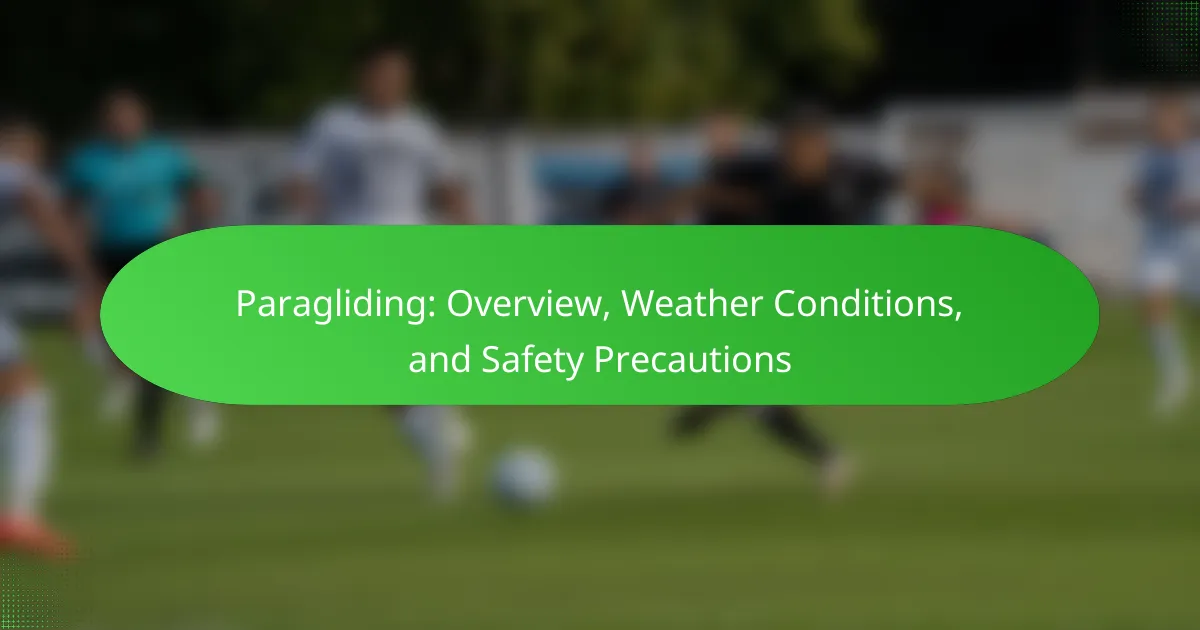Paragliding offers an exhilarating way to experience flight, but it requires careful attention to safety and environmental factors. This article explores essential gear components, ideal weather conditions, and vital safety precautions to ensure a secure and enjoyable paragliding experience. Understanding these elements can significantly enhance your flying skills and overall safety in the air.

What are the essential components of paragliding gear?
The essential components of paragliding gear include the wing, harness, reserve parachute, and helmet. Each component plays a crucial role in safety and performance.
The wing, or canopy, is designed to provide lift and stability during flight. It comes in various sizes and shapes, tailored to different weights and flying styles.
The harness secures the pilot and connects them to the wing. It should be comfortable and well-fitted to ensure safety and ease of movement.
The reserve parachute is a critical safety feature, used in emergencies to provide a safe landing if the main wing fails.
Lastly, the helmet protects the pilot’s head from impacts during takeoff, flight, or landing. Choosing high-quality gear enhances overall safety and flying experience.
How does each component contribute to safety and performance?
Each component of paragliding enhances safety and performance through specific functions. The wing design, including the canopy shape and material, affects lift and stability, ensuring controlled flight. The harness provides secure attachment and comfort, allowing pilots to manage weight distribution effectively. Weather conditions, such as wind speed and thermal activity, influence flight dynamics, requiring pilots to adapt for safety. Safety equipment, like reserve parachutes and helmets, offers protection against potential accidents, enhancing overall confidence and performance in the air.
Which brands are recognized for quality paragliding equipment?
Brands recognized for quality paragliding equipment include Ozone, Gin Gliders, Advance, Skywalk, and Nova. These brands are known for their durability, performance, and safety features. Ozone, for instance, offers a range of wings suitable for both beginners and experienced pilots, emphasizing innovation and technology. Gin Gliders is celebrated for its lightweight designs, enhancing maneuverability. Advance focuses on precision engineering, ensuring reliable flight experiences. Skywalk integrates safety with performance, while Nova is known for its user-friendly designs and versatility.

What weather conditions are ideal for paragliding?
Ideal weather conditions for paragliding include clear skies, light winds, and stable air. Optimal temperatures range from 15 to 25 degrees Celsius. Wind speeds should ideally be between 5 to 15 km/h. Thermal activity is beneficial, providing lift. Avoid flying in storms or turbulent conditions.
How do wind patterns affect paragliding safety?
Wind patterns significantly impact paragliding safety by affecting flight stability and control. Strong winds can create turbulence, increasing the risk of accidents. Pilots must assess wind direction and speed before launching. Crosswinds can complicate landings, while thermals can provide lift but also introduce unpredictability. Understanding these factors is essential for safe paragliding.
What are the signs of changing weather that paragliders should watch for?
Paragliders should watch for changes in wind patterns, cloud formations, temperature shifts, and humidity levels. These signs indicate potential weather changes that can affect safety.
1. Wind direction shifts can signal approaching storms or changing weather conditions.
2. Darkening clouds often suggest rain or thunderstorms.
3. Sudden temperature drops may indicate an incoming front.
4. Increased humidity can lead to fog or turbulence.
Being aware of these signs enhances safety during paragliding.

What safety precautions should be taken before paragliding?
Before paragliding, ensure you check weather conditions, equipment integrity, and personal health. Assess wind speed, direction, and potential hazards. Verify that your gear, including the wing and harness, is in good condition. Confirm that you are physically fit and have completed necessary training.
How can pre-flight checks ensure a safe experience?
Pre-flight checks are essential for ensuring a safe paragliding experience. They help identify equipment issues, assess weather conditions, and confirm pilot readiness. Thorough inspections reduce risks and enhance overall safety. Key checks include verifying harness integrity, checking wing condition, and evaluating wind speed. As a result, these measures significantly decrease the likelihood of accidents, providing a secure environment for paragliders.
What role does training play in paragliding safety?
Training is crucial for paragliding safety as it equips pilots with essential skills and knowledge. Proper training helps pilots understand weather conditions, equipment handling, and emergency procedures. It reduces the risk of accidents by fostering decision-making skills in challenging situations. Additionally, trained pilots can better assess their limits and those of their equipment, enhancing overall safety during flights.

What are common challenges faced by paragliders in different regions?
Paragliders face various challenges influenced by regional weather conditions and terrain. These include unpredictable winds, varying thermal activity, and local regulations.
In mountainous regions, paragliders often contend with turbulence caused by terrain features. Coastal areas may present challenges like sea breezes and changing weather patterns. In flatlands, thermal conditions can be less predictable, impacting flight duration and safety.
Additionally, paragliders must navigate local airspace restrictions and varying access to launch sites. Understanding these elements is crucial for safe and enjoyable flights.
How do terrain types influence paragliding experiences?
Terrain types significantly influence paragliding experiences by affecting flight conditions, safety, and overall enjoyment. Mountainous terrains offer thermals and updrafts, enhancing soaring potential. Coastal areas provide steady sea breezes, ideal for beginners. Flatlands may present challenges due to weaker lift. Each terrain type shapes the pilot’s experience through unique weather patterns and landscape features, making it crucial to choose the right location for optimal paragliding.
What unique risks are associated with paragliding in mountainous areas?
Paragliding in mountainous areas carries unique risks such as sudden weather changes, turbulence, and altitude-related issues. These factors can lead to challenging flying conditions and increased potential for accidents. Sudden storms can develop quickly, reducing visibility and making landing difficult. Additionally, strong thermals and wind shear can cause unpredictable flight behavior. Pilots must also be aware of altitude sickness, which can impair judgment and physical ability. Proper training and preparation are essential to mitigate these risks.

What are the best practices for emergency situations while paragliding?
To ensure safety during emergency situations while paragliding, follow these best practices: maintain calm, assess the situation, and execute emergency procedures. Familiarize yourself with your equipment and emergency protocols. Always have a plan for landing zones and communicate with your team. Regular training and practice can enhance your response to emergencies, reducing risks significantly.
How can paragliders effectively handle equipment failure mid-flight?
Paragliders can effectively handle equipment failure mid-flight by remaining calm and following established emergency procedures. First, assess the situation to determine the type of failure, such as a malfunctioning wing or harness.
Next, execute the appropriate response, which may include initiating a controlled descent or attempting to stabilize the glider. Always prioritize maintaining altitude and controlling the descent rate.
Additionally, practice regular equipment checks and emergency drills to enhance preparedness. Training in various scenarios improves response efficacy, reducing risks during actual flights.
What strategies can be employed for safe landings in emergencies?
Employing strategies for safe landings in emergencies involves several key techniques. Pilots should maintain situational awareness to identify suitable landing zones. Utilizing controlled descent techniques, such as flaring at the right altitude, helps manage speed and direction. Practicing emergency maneuvers regularly enhances readiness. It’s crucial to remain calm and assess the conditions before landing. Having a backup plan, including alternate landing sites, ensures preparedness for unexpected situations.

What are the benefits of joining a paragliding community?
Joining a paragliding community offers numerous benefits, including enhanced safety, skill development, and social connections. Community members share valuable knowledge about weather conditions and safety precautions, reducing risks. Additionally, participating in group activities fosters camaraderie and support, making the experience more enjoyable. Regular interaction with experienced pilots can accelerate learning and improve overall flying techniques.
How does community support enhance safety and learning?
Community support enhances safety and learning in paragliding by fostering shared knowledge and experience. Local pilots often share insights about weather conditions, techniques, and safety precautions. This collective wisdom can significantly reduce risks associated with flying. Additionally, community events and training sessions provide practical learning opportunities, reinforcing safety protocols through hands-on experience. Engaging with a supportive network encourages vigilance and accountability, which are crucial for maintaining safety standards in paragliding.
What resources are available for novice paragliders through local clubs?
Local paragliding clubs offer a variety of resources for novice paragliders. These include training programs, experienced instructors, and access to equipment rentals. Clubs often provide safety briefings and organized flying events to enhance skills and knowledge. Members can also benefit from shared experiences and mentorship opportunities, fostering a supportive community.
What practical tips can improve your paragliding skills in 2025?
To improve your paragliding skills in 2025, focus on consistent practice, understanding weather patterns, and prioritising safety. Regularly flying in varied conditions enhances adaptability and decision-making. Study meteorology to interpret weather forecasts effectively. Always wear appropriate safety gear and participate in training sessions to refine techniques. Engaging with experienced pilots for feedback can also accelerate skill development.
